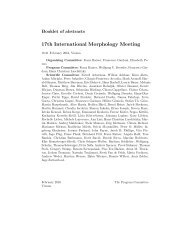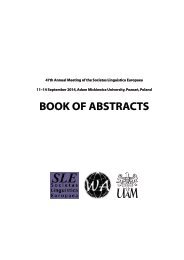Jabberwocky priming
Jabberwocky priming
Jabberwocky priming
You also want an ePaper? Increase the reach of your titles
YUMPU automatically turns print PDFs into web optimized ePapers that Google loves.
Again, the same target words were used following incongruent constructions todetermine baseline RTs for each word (between subjects).Each block consisted of two phases: An ‘acclamation’ phase (12 trials), explainedbelow, and an ‘experimental’ phase (8 trials). The overall structure of the experiment wasas follows:1. Practice (12)-Break-2. High Frequency – acclamation (12 trials: 6 words and 6 non-words)3. High Frequency - experimental (8 trials: 4 experimental words and 4 nonwords)-Break-4. Low Frequency – acclamation (12)5. Low Frequency – experimental (8)-Break-6. Semantics – acclamation (12)7. Semantics – experimental (8)The reason for including the acclamation phase was to condition participants toattend carefully to target forms in order to avoid floor effects in response times. If wordshad been sufficiently distinct from non-words, the task would have been quite easy andmight well have led to insufficient variability in response times. We therefore includedtarget words and non-words that were minimally different from each other and from theexperimental items in that block. For example, in the high frequency associates block, theexperimental words were gave, put, make, and took. The words in the acclamation phaseincluded verbs that are phonetically similar to those in the experimental phase (e.g. have,met, stood, saw), as well as non-words that are also phonetically similar (stook, puv, goot,gade). In the acclimation phase, participants saw 6 non-experimental real verbs and 6







